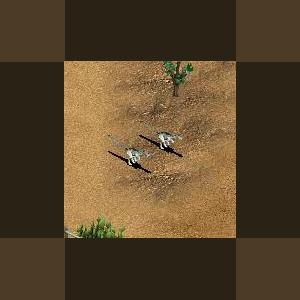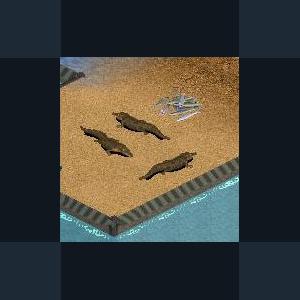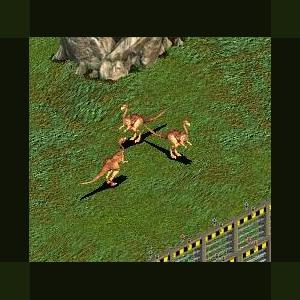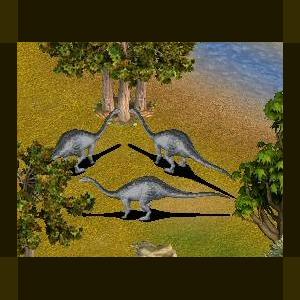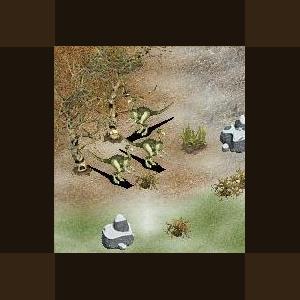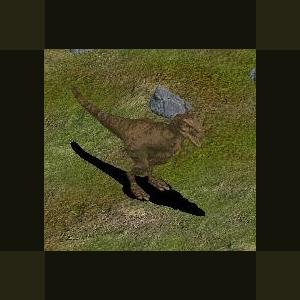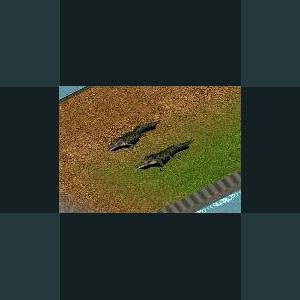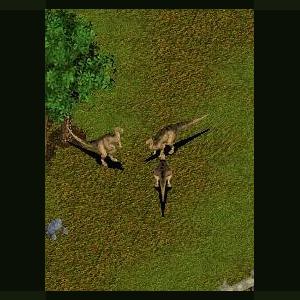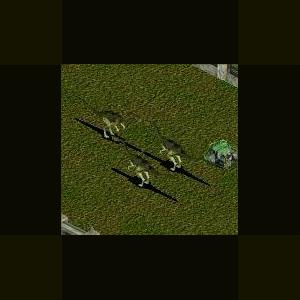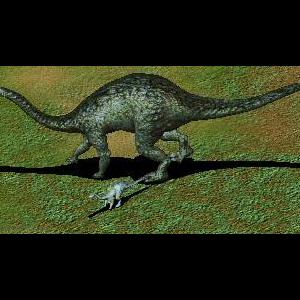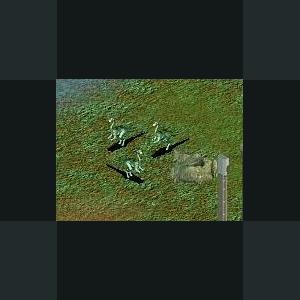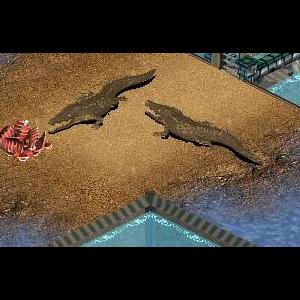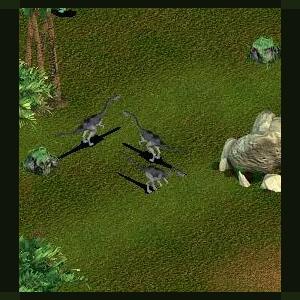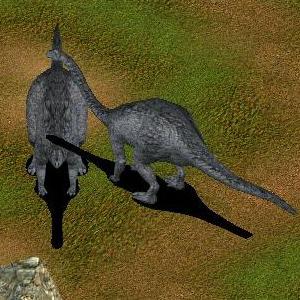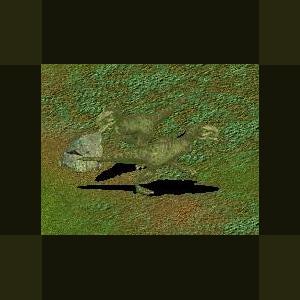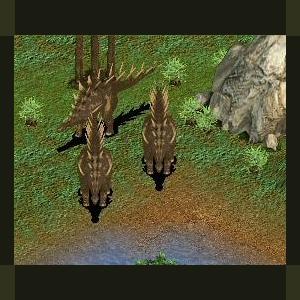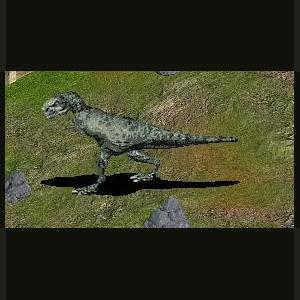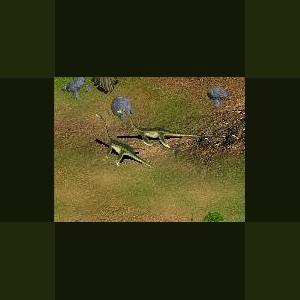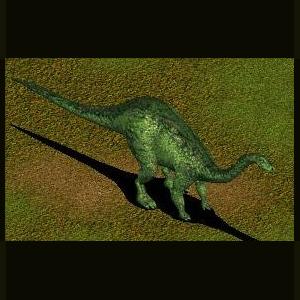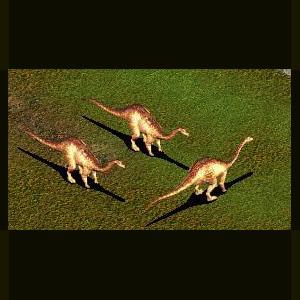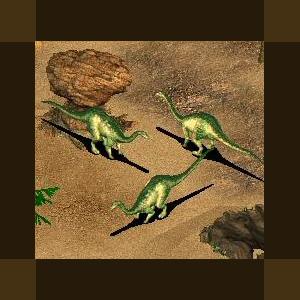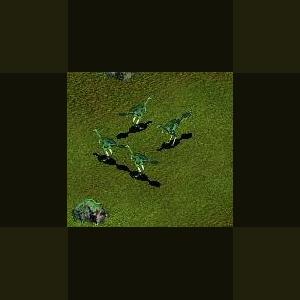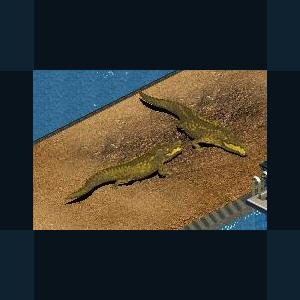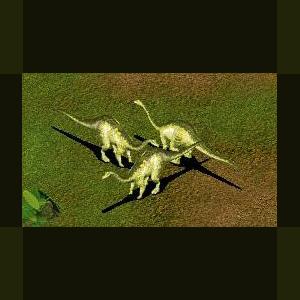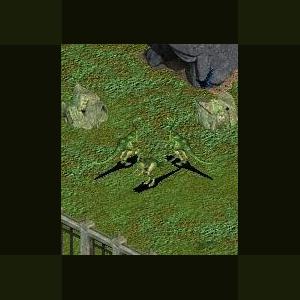Dinosaurs
Creatures from another age
241 files
-
Segisaurus by Moondawg
By Guest
Segisaurus
Segisaurus (meaning "Segi canyon lizard") was a small coelophysoid theropod dinosaur, that measured approximately 1 metre in length. The only known specimen was discovered in 1933 in early Jurassic strata in Tsegi Canyon, Arizona, for which it was named. Segisaurus is the only dinosaur to have ever been excavated from the area. It was later described in 1936 by the paleontologist Charles Lewis Camp. The fragmentary fossil skeleton consisted of portions of the limbs, pelvis, and vertebrae, but no cranial material was located. Segisaurus appears to have been closely related to the much more well-known Coelophysis. One distinction, however, was that Segisaurus had solid bones, while those of Coelophysis' were hollow. This even made some scientists consider if Segisaurus was even a theropod at all. Later investigations into the specimen's pelvic remains in 2005 lead scientists to believe that Segisaurus was in fact related more closely to Procompsognathus.
Segisaurus lived about 180 million years ago during the Jurassic period. Segisaurus was roughly the size of a goose and was a primitive bipedal theropod. Segisaurus was roughly 1 metre long, half a metre tall and weighed about 4-7 kilograms. It was nimble and insectivorous, although it may have scavenged meat also. It was bird-like in structure, with a flexible neck, elongated neck and a stubbish body. Segisaurus was three-toed and had powerful legs that were long compared to its body length. Like its legs, Segisaurus had a long tail and long forearms. Its collar bone was not unlike a bird's, thus strengthening scientists' arguments that dinosaurs were related to avians.
Segisaurus is described from the only specimen ever found. The holotype, however, was a sub-adult, so that the full size of Segisaurus as an adult may never be known. Strangely, clavicles were found on the Segisaurus specimen, which were unknown in other dinosaurs from that era.
The first discovery of Segisaurus was by Max Littlesalt, a Navajo Indian who kept livestock inside Tsegi Canyon. After discovering the remains, Littlesalt pointed out the fossils to archeologists on an expedition inside the canyon. Other than the first finding of Segisaurus, no other specimens have been discovered. After its initial description by Charles Lewis Camp, the holotype went relatively ignored for the next half century. When the specimen was investigated during this period, all who viewed it commented on the presence of clavicles and the solid bone structures the dinosaur had. According to recent reports, Segisaurus is vital in understanding the evolution of early theropods.
When the specimen of Segisaurus was discovered, Camp likened it to that of a "sitting hen", due to the position the dinosaur's remains were in. Other theropods used this positions to sleep or stay sheltered during large sand storms, and indeed the Segisaurus holotype was found in a bed of sand stone, suggesting that the dinosaur had been submerged in a layer of sand and died. This is still only a hypothesis, as no nest or den materials were discovered along the Segisaurus specimen. Another speculative interpretation from Camp has attracted less attention: that the "splint-like" neck ribs supported a Draco-like patagium along the neck, to improve the animal's ability to move quickly.
In September 2005, the Journal of Vertebrate Paleontology published a report which re-examined the remains of the Segisaurus holotype. The authors concluded, that although very unusual, Segisaurus was firmly a coelophysoid. They also noted that Segisaurus was probably a relative of Procompsognathus.
http://en.wikipedia.org/wiki/Segisaurus
158 downloads
0 comments
Updated
-
Calsoyasuchus by Moondawg
By Guest
Calsoyasuchus
Calsoyasuchus (meaning "[Dr. Kyril] Calsoyas' crocodile") is a genus of goniopholidid mesoeucrocodylian that lived in the Early Jurassic. Its fossilzed remains were found in the Sinemurian-Pliensbachian-age Kayenta Formation on Navajo Nation land in Coconino County, Arizona, United States. Formally described as C. valliceps, it is known from a single incomplete skull which is unusually derived for such an early crocodile relative. This genus was described in 2002 by Ronald Tykowski and colleagues; the species name means "valley head" and refers to a deep groove along the midline of the nasal bones and frontal bones.
The holotype skull that would be named Calsoyasuchus was discovered in 1997 by members of an expedition composed of crews from Texas Memorial Museum of the University of Texas at Austin, the Museum of Comparative Zoology at Harvard University, and the Seba Dalkai Navajo Nation School. It was found in the middle third of the silty facies of the Kayenta Formation, near the Adeii Eechii Cliffs. The skull is missing the lower jaws, part of the palate, most of the suspensorium (the bones that make up the region where the upper and lower jaws articulate), and the occiput and braincase. Sutures between the skull bones are mostly fused. As preserved, it is about 38.0 centimeters (15.0 in) long, making its owner a moderately sized animal.
The skull was long, low, and curved so that both extremities were higher than the middle. The premaxilla bones that formed the end of the snout were enlarged to form a wide tip; there were at least four teeth in the right premaxilla and five in the left. The left maxilla (main tooth-bearing bone of the upper jaw) is more complete than the right, and had at least 29 teeth. There was a deep groove along the midline of the nasals and the frontals; the frontals were fused into a single bone, as is seen in other adult mesoeucrocodylians. Unlike derived neosuchians, it had external antorbital fenestrae. Tykowski and colleagues subjected the skull to CT scanning, which revealed internal cavities and air passages, and showed that it had a double-walled secondary palate similar to that of true crocodylians, and similar pneumatic cavities as well.
Tykowski and colleagues performed a cladistic phylogenetic analysis with their new taxon, and found that it grouped with Goniopholis, Sunosuchus, and, most closely, with Eutretauranosuchus in a weakly supported clade, Goniopholididae. They noted that the skull of Calsoyasuchus is very similar to some goniopholid skulls from the younger, Upper Jurassic Morrison Formation. Calsoyasuchus pushes back the earliest occurrence of goniopholids from the Late Jurassic into the Early Jurassic, and not only helps to bridge a temporal gap between groups of crocodyliforms, but also a morphological gap. It also implies that some groups of crocodyliforms have long undiscovered histories.
During the Sinemurian and Pliensbachian ages of the Early Jurassic, the Kayenta Formation had a diverse fauna, with the remains of caecilians, frogs, turtles, at least five other taxa of crocodylomorphs, pterosaurs, theropod, sauropodomorph, and ornithischian dinosaurs, and early relatives of mammals (tritylodontids and morganucodontids).
251 downloads
0 comments
Updated
-
Hypsilophodon by Moondawg
By Guest
Hypsilophodon
Hypsilophodon ( meaning 'high-crested tooth') is an ornithopod dinosaur genus from the Early Cretaceous Period of Europe. It was a small bipedal animal with an herbivorous or possibly omnivorous diet. Abundant fossil remains found in England indicate that Hypsilophodon reached about 2 meters (6.5 feet) in length.
The first remains of Hypsilophodon were recovered in the early days of paleontology in 1849. However, at the time, the bones were thought to belong to a young Iguanodon. It was not until 1870 that paleontologist T. H. Huxley was able to publish a full description of Hypsilophodon as we know it today. He had been provided with a number of skeletons by the Reverend William Fox, after whom the first species of Hypsilophodon was named.
Early paleontologists modeled the body of this small, bipedal, herbivorous dinosaur in various ways. In 1882 some paleontologists suggested that, like a modern tree-kangaroo, Hypsilophodon was able to climb trees in order to seek shelter. This was the accepted view for almost a century. However, Peter M. Galton finally performed more accurate analysis of the musculo-skeletal structure in 1974 and convinced most paleontologists that Hypsilophodon remained firmly on the ground.
Since then, three near-complete and over twenty minor finds have been made, especially on the Isle of Wight, off the south coast of England. Other finds have been made in southern England and Portugal.
Another misconception concerning the anatomy of Hypsilophodon was that it was armoured. The putative armour, consisting of thin mineralized plates from the torso, instead appear to be examples of intercostal plates associated with the rib cage. Such plates are better known from Talenkauen and Thescelosaurus, and were probably cartilaginous in origin.
There is only one known species of Hypsilophodon, Huxley's original H. foxii. Galton and Jensen named another species in 1979, H. wielandi, which is based on a thigh bone from South Dakota, USA, but it is now regarded as an indeterminate basal ornithopod.
Hypsilophodon was a relatively small dinosaur. While not quite so small as, for example, Compsognathus, Hypsilophodon was only around 2.3 metres in length. It would have reached approximately waist-height on a modern man and would have weighed about the same, at 50 to 70 kilograms (110 to 150 lb).
Like most small dinosaurs, Hypsilophodon was bipedal and ran on two legs. Its entire body was built for running; a light-weight, minimized skeleton, low, aerodynamic posture, long legs and stiff tail for balance all would have allowed it to travel remarkably fast for its size.
Due to its small size, Hypsilophodon fed on low-growing vegetation, most likely preferring young shoots and roots in the manner of modern deer. The structure of its skull, with the teeth set far back into the jaw, strongly suggests that it had cheeks, an advanced feature that would have facilitated the chewing of food. There were twenty-eight to thirty ridged teeth in the animal's jaw which, due to their alternate arrangement, appear to have been self-sharpening. As in almost all dinosaurs and certainly all the ornithischians, the teeth were continuously replaced.
The level of parental care in this dinosaur has not been defined, although a neatly-arranged nest has been found, suggesting that some care was taken before hatching. Fossils of large groups have been found, so it is likely that the animals moved in herds. For these reasons, the hypsilophodonts, particularly Hypsilophodon, have often been referred to as the "deer of the Mesozoic".
Despite living in the last of the periods in which dinosaurs walked the earth, the Cretaceous, Hypsilophodon had a number of primitive features. For example, there were five digits on each 'hand' and four on each foot. Most dinosaurs had lost these redundant features by the Cretaceous period. Also, although it had a beak like most ornithischians, Hypsilophodon still had pointed triangular teeth in the front of the jaw. Most herbivorous dinosaurs had, by this stage, become sufficiently specialized that the front teeth had been altogether lost (although there is some debate as to whether these teeth may have had a specialized function in Hypsilophodon).
The group Hypsilophodontidae remained remarkably static from the late Jurassic to the end of the Cretaceous. It is possible that this was because the animals were almost perfectly adapted to their lifestyle, therefore selective pressure, it is assumed, was low.
http://en.wikipedia.org/wiki/Hypsilophodon
191 downloads
0 comments
Updated
-
Massospondylus by Moondawg
By Guest
Massospondylus
Massospondylus (Greek 'elongated vertebra'), formerly known as Aristosaurus, was an Early Jurassic Period prosauropod, although, if Aetonyx is the same as Massospondylus, it lived from the Late Triassic as well. It was probably a plant eater (herbivore), although it is speculated that the prosauropods may have been omnivorous. This dinosaur was named by Sir Richard Owen in 1854, from remains found in South Africa. It is thus one of the first dinosaurs to be named.
Massospondylus (pronounced,(masson, "longer") and (spondylos, "vertebra") is a genus of prosauropod dinosaur from the early Jurassic Period (Hettangian to Pliensbachian ages, ca. 200–183 million years ago). It was described by Sir Richard Owen in 1854 from remains found in South Africa, and is thus one of the first dinosaurs to have been named. Fossils have since been found at other locations in South Africa, Lesotho, and Zimbabwe. Further material from Arizona's Kayenta Formation, India, and Argentina has been assigned to this genus, but may not belong to Massospondylus.
The type, and only universally recognized, species, is M. carinatus, although six other species have been named during the past 150 years. Prosauropod systematics have undergone numerous revisions during the last several years, and many scientists disagree where exactly Massospondylus lies on the dinosaur evolutionary tree. The family name Massospondylidae was once coined for the genus, but because knowledge of prosauropod relationships is in a state of flux, it is unclear which other dinosaurs—if any—belong in a natural grouping of massospondylids; several 2007 papers support the family's validity.
Although Massospondylus was long depicted as quadrupedal, a 2007 study found it to be bipedal. It was probably a plant eater (herbivore), although it is speculated that the prosauropods may have been omnivorous. This animal, 4–6 meters (13–20 feet) long, had a long neck and tail, with a small head and slender body. On each of its forefeet, it bore a sharp thumb claw that was used in defense or feeding. Recent studies indicate Massospondylus grew steadily throughout its lifespan, possessed air sacs similar to those of birds, and may have cared for its young.
Massospondylus was a mid-sized prosauropod that was around 4 meters (13 ft) in length and weighed approximately 135 kilograms (300 lb), although a few sources have estimated its length at up to 6 meters (20 ft). Although long assumed to have been quadrupedal, a 2007 anatomical study of the forelimbs has questioned this, arguing that their range of motion precluded effective habitual quadrupedal gait. The study also ruled out the possibility of "knuckle-walking" and other forms of locomotion that would avoid the issue of the limited ability of Massospondylus to pronate its hands. Although its mass suggests a quadrupedal nature, it would have been restricted to its hind legs for locomotion.
Massospondylus was a typical prosauropod in most other respects. It possessed a slender body and long neck, with around nine long cervical (neck) vertebrae, 13 dorsal (back) vertebrae, three sacral (hip) vertebrae, and at least 40 caudal (tail) vertebrae. The pubis faced forward, as with most saurischians. It had a slighter build than that of Plateosaurus, an otherwise similar prosauropod dinosaur. A recent discovery shows that Massospondylus possessed well-developed clavicles, joined in a furcula-like arrangement, suggesting both that it had immobile shoulder blades and that clavicles were not rudimentary and nonfunctional in those dinosaurs that did not have true furculae. This discovery also indicates that the furcula of birds is derived from clavicles.
Like Plateosaurus, it had five digits on each foot, with a large thumb claw used for feeding or defense against predators. The fourth and fifth digits of the forepaws were tiny, giving the forepaws a lopsided look. The 2007 study indicated that Massospondylus held its manus (hands) in a semi-supinated ("prayer-like") orientation, with the palmar surfaces facing one another; the wrist was never found rotated in articulated (still-connected) fossil specimens.
The small head of Massospondylus was approximately half the length of the femur. Numerous openings, or fenestrae, in the skull reduced its weight and provided space for muscle attachment and sensory organs. These fenestrae were present in pairs, one on each side of the skull. At the front of the skull were two large, elliptical nares. The orbits were proportionally larger in Massospondylus than in related genera such as Plateosaurus. The antorbital fenestrae, smaller than those seen in Plateosaurus, were situated between the eyes and the nose. At the rear of the skull were two more pairs of temporal fenestrae: the lateral temporal fenestrae immediately behind the eye sockets and the supratemporal fenestrae on top of the skull. Small fenestrae also penetrated each mandible. The shape of the skull is traditionally restored as wider and shorter than that of Plateosaurus, but this appearance may be due just to differential crushing experienced by the various specimens.Some features of the skull are variable between individuals; for example, the thickness of the upper border of the orbit and the height of the posterior maxilla. These differences may be due to sexual dimorphism or individual variation.
As with other prosauropods, it has been proposed that Massospondylus had cheeks. This theory was proposed because there are a few large holes for blood vessels on the surfaces of the jaw bones, unlike the numerous small holes present on the jaws of cheekless reptiles. The cheeks would have prevented food from spilling out when Massospondylus ate. Crompton and Attridge (1986) described skulls of Massospondylus as possessing pronounced overbites and suggested the presence of a horny beak on the tip of the lower jaw to make up the difference in length and account for tooth wear on the teeth at the tip of the snout. However, this was later shown to be a misinterpretation based on crushing in a top–bottom plane. Skulls not crushed in this orientation do not show an overbite. There also seems to be some variation of tooth morphology based on the position of teeth in the jaw. The heterodonty present in Massospondylus is greater than that present in Plateosaurus, although unsurprisingly not as pronounced as the specialization of teeth in Heterodontosaurus. Teeth closer to the front of the snout had round cross-sections and tapered to points, unlike the back teeth, which were spatulate and had oval cross-sections.
Many species have been named, although most are no longer considered valid. M. carinatus, named by Richard Owen, is the type species. Other named species include: M. browni (Seeley, 1895), M. harriesi (Broom 1911), M. hislopi (Lydekker, 1890), M. huenei (Cooper, 1981), M. rawesi (Lydekker, 1890), and M. schwarzi (Haughton, 1924).
M. browni, M. harriesi, and M. schwarzi were all found in the Upper Elliot Formation of Cape Province, South Africa. All three are based on fragmentary material, and were regarded as indeterminate in the most recent review. M. browni is based on two cervical, two back, and three caudal vertebrae and miscellaneous hind limb elements. M. harriesi is known from a forelimb.M. schwarzi is known from an incomplete hind limb and sacrum. M. hislopi and M. rawesi were named from fossils found in India. M. hislopi is based on vertebrae from the Upper Triassic Maleri Formation of Andhra Pradesh, whereas M. rawesi is based on a tooth from the Upper Cretaceous Takli Formation of Maharashtra. M. hislopi was tentatively retained as an indeterminate sauropodomorph in the latest review,but M. rawesi may be a theropod or nondinosaur. M. huenei is a combination derived by Cooper for Lufengosaurus huenei, as he considered Lufengosaurus and Massospondylus to be synonyms. This synonymy is no longer accepted.
Several dinosaurs are often considered synonymous with Massospondylus. These include Aristosaurus, Dromicosaurus, Gryponyx, Hortalotarsus, Leptospondylus, and Pachyspondylus, which are dubious names of little scientific value. Hortalotarsus skirtopodus was named by Harry Seeley in 1894. The fossils consist of partial leg bones. The following year, Richard Owen named a few fossil vertebrae Leptospondylus capensis and Pachyspondylus orpenii. These fragmentary fossils were later destroyed in World War II. Aristosaurus erectus was named by E.C.N. van Hoepen in 1920 based on a nearly complete skeleton. Hoepen also named Dromicosaurus gracilis, which consisted of a partial skeleton. Gryponyx taylori was named by Sidney H. Haughton in 1924. It consists of hip bones. All of the above fossils come from the Hettangian or Sinemurian faunal stages of South Africa, where Massospondylus has been found. Under the rules of zoological nomenclature, these names are junior synonyms. They were named after Massospondylus was described in a scientific paper; the name Massospondylus thus takes priority.
Massospondylus is a prosauropod, a grouping of early saurischian dinosaurs that lived during the Triassic and Jurassic, but which had died out by the end of the Jurassic. Other members of the group include Plateosaurus, Yunnanosaurus, and Riojasaurus. Basal sauropodomorph systematics continue to undergo revision, and many genera once considered classic prosauropods have recently been removed from the group in phylogenetic nomenclature, on the grounds that their inclusion would not constitute a clade (a natural grouping containing all descendants of a single common ancestor). Exactly which animals constitute a monophyletic (natural grouping) of prosauropods is unclear. Yates and Kitching (2003) published a clade consisting of Riojasaurus, Plateosaurus, Coloradisaurus, Massospondylus, and Lufengosaurus. Galton and Upchurch (2004) included Ammosaurus, Anchisaurus, Azendohsaurus, Camelotia, Coloradisaurus, Euskelosaurus, Jingshanosaurus, Lessemsaurus, Lufengosaurus, Massospondylus, Melanorosaurus, Mussaurus, Plateosaurus, Riojasaurus, Ruehleia, Saturnalia, Sellosaurus, Thecodontosaurus, Yimenosaurus and Yunnanosaurus in a monophyletic Prosauropoda. Wilson (2005) considered Massospondylus, Jingshanosaurus, Plateosaurus, and Lufengosaurus a natural group, with Blikanasaurus and Antetonitrus possible sauropods. Bonnan and Yates (2007) considered Camelotia, Blikanasaurus and Melanorosaurus possible sauropods. Yates (2007) placed Antetonitrus, Melanorosaurus, and Blikanasaurus as basal sauropods and declined to use the term Prosauropoda, as he considered it synonymous with Plateosauridae. However, he did not rule out the possibility that a small group of prosauropods consisting of Plateosaurus, Riojasaurus, Massospondylus and their closest kin were monophyletic.
Massospondylus is the type genus of the proposed family Massospondylidae, to which it gives its name. The Massospondylidae family may also include Yunnanosaurus, although Lu et al. (2007) placed Yunnanosaurus in its own family. Yates (2007) considered Massospondylus, Coloradisaurus, and Lufengosaurus massospondylids, with Yunnanosaurus in Anchisauria. Smith and Pol (2007) also found a Massospondylidae in their phylogenetic analysis, including Massospondylus, Coloradisaurus, and Lufengosaurus, as well as their new genus, Glacialisaurus.Adeopapposaurus, based on the fossils once thought to belong to a South American form of Massospondylus, was also classified as a massospondylid.
The faunas and floras of the Early Jurassic were similar worldwide, with conifers adapted for hot weather becoming the common plants, and prosauropods and basal theropods the main constituents of a worldwide dinosaur fauna. The environment of early Jurassic southern Africa has been described as a desert. African Massospondylus was a contemporary of early crocodylomorphs; tritylodontid and trithelodontid therapsids; morganucodontid mammals; and dinosaurs including the small theropod Megapnosaurus rhodesiensis; a species of Melanorosaurus (M. thabanensis); and several genera of early ornithischians, such as Lesothosaurus and the heterodontosaurids Abrictosaurus, Heterodontosaurus, and Lycorhinus.
It is not clear which carnivores may have preyed on Massospondylus. Most of the theropods which have been discovered in rocks of Early Jurassic age in southern Africa, such as Megapnosaurus, were smaller than mid-sized prosauropods like Massospondylus. These smaller predators have been postulated as using fast slashing attacks to wear down prosauropods, which could have defended themselves with their large hand and foot claws. The 6-meter-(20 ft-) long carnivorous theropod Dracovenator lived during the same period (Hettangian to Sinemurian stages) as Massospondylus and has also been found in the Elliot Formation of South Africa.
As with all dinosaurs, much of the biology of Massospondylus, including its behavior, coloration, and physiology, remains unknown. However, recent studies have allowed for informed speculation on subjects such as growth patterns, diet,posture, reproduction, and respiration.
A 2007 study suggested that Massospondylus may have used its short arms in defense from predators ("defensive swats"), in intraspecies combat, or in feeding, although its arms were too short to reach its mouth. Scientists speculate that Massospondylus could have used its large pollex (thumb) claw in combat, to strip plant material from trees,digging, or for grooming.
A 2005 study indicated that Massospondylus' sister taxon, Plateosaurus, exhibited growth patterns affected by environmental factors. The study indicated that when food was plentiful, or when the climate was favorable, Plateosaurus exhibited accelerated growth. This pattern of growth is called "developmental plasticity". It is unseen in other dinosaurs, including Massospondylus, despite the close relationship between Plateosaurus and Massospondylus. The study indicated that Massospondylus grew along a specific growth trajectory with little variation in the growth rate and ultimate size of an individual.Another study of age determination indicated that Massospondylus grew at a maximum rate of 34.6 kg (76.3 lb) per year and was still growing at around 15 years of age.
Prosauropods such as Massospondylus may have been herbivorous or omnivorous. As recently as the 1980s, paleontologists debated the possibility of carnivory in prosauropods. However, the hypothesis of carnivorous prosauropods has been discredited, and all recent studies favor a herbivorous or omnivorous lifestyle for these animals. Galton and Upchurch (2004) found that cranial characteristics (such as jaw articulation) of most prosauropods are closer to those of herbivorous reptiles than those of carnivorous ones, and the shape of the tooth crown is similar to those of modern herbivorous or omnivorous iguanas. The maximum width of the crown was greater than that of the root, resulting in a cutting edge similar to those of extant herbivorous or omnivorous reptiles. Barrett (2000) proposed that prosauropods supplemented their herbivorous diets with small prey or carrion. Gastroliths (gizzard stones) have been found in association with Massospondylus fossils in South Africa, and with a Massospondylus-like animal from the Late Triassic of Virginia. Massospondylus swallowed these stones to aid in digestion; muscular contractions in the creature's gizzard would have pulverized swallowed plant material, compensating for its inability to chew.
In 1977, seven 190-million-year-old Massospondylus eggs were found in Golden Gate Highlands National Park in South Africa by James Kitching, who identified them as most likely belonging to Massospondylus. It was nearly 30 years before extraction was started on the fossils of the 15-centimeter- (6 in-) long embryos. They remain the oldest dinosaur embryos ever found. Notably, the near-hatchlings had no teeth, suggesting they had no way of feeding themselves. Based on the lack of teeth and the animal's body proportions, scientists speculate that postnatal care might have been necessary. The four legs of the near-hatchlings were of equal length, indicating that newly hatched Massospondylus were quadrupedal. The skull and eyes were proportionately oversized when compared to adults, as is common in other very young vertebrates, although the skulls of juveniles were taller and more narrow as well. The quadrupedality of the hatchlings suggests that the quadrupedal posture of later sauropods may have evolved from retention of juvenile characteristics in adult animals, an evolutionary phenomenon known as pedomorphosis.
Many saurischian dinosaurs possessed vertebrae and ribs that contained hollowed-out cavities (pneumatic foramina), which reduced the weight of the bones and may have served as a basic 'flow-through ventilation' system similar to that of modern birds. In such a system, the neck vertebrae and ribs are hollowed out by the cervical air sac; the upper back vertebrae, by the lung; and the lower back and sacral (hip) vertebrae, by the abdominal air sac. These organs constitute a complex and very efficient method of respiration. Prosauropods are the only major group of saurischians without an extensive system of pneumatic foramina. Although possible pneumatic indentations have been found in Plateosaurus and Thecodontosaurus, the indentations were very small. One study in 2007 concluded that prosauropods like Massospondylus likely had abdominal and cervical air sacs, based on the evidence for them in sister taxa (theropods and sauropods). The study concluded that it was impossible to determine whether prosauropods had a bird-like flow-through lung, but that the air sacs were almost certainly present.
188 downloads
0 comments
Updated
-
Leaellynasaura by Moondawg
By Guest
Leaellynasaura
Leaellynasaura was a small herbivorous ornithopod dinosaur of about 60-90 cm in length from the earliest Cretaceous, first discovered in Dinosaur Cove, Australia.
It was an Australian polar dinosaur. Strangely enough, at this period in time, Victoria would have been well within the Antarctic Circle, which is now very cold. This means that Leaellynasaura was living and apparently thriving much further south than any reptile could today. This is particularly relevant due to Cryolophosaurus being discovered in Antarctica, thus further suggesting the idea that dinosaurs could live under conditions which were once thought unsuitable for their kind. It is possible that the sun would not have risen for several weeks or months in the winter, depending on latitude, which means that Leaellynasaura would have had to live in the dark for perhaps months at a time. This is particularly relevant to the fact that Leaellynosaura had very big eyes and its brain had large optic lobes, as if it had evolved to be routinely active in the dark.Evidence found on the coast of western Victorian coastline suggests that polar dinosaurs, such as Leaellynasaura, may have dug burrows to nurture their young during the polar winter.
Regardless, the fact that it lived in extremely cold temperatures led many scientists to believe that Leaellynasaura was warm-blooded.
No complete skeletons have been found of Leaellynasaura. The species is known from many isolated limb bones, ribs, vertebrae, jaws, teeth and one partial skull.
The type species is Leaellynasaura amicagraphica. It was described in 1989. It was named after Leaellyn Rich, the daughter of the palaeontologist couple Tom Rich and Patricia Vickers-Rich who discovered it. Leaellynasaura was a hypsilophodont, a rather basal ornithopod. Like all ornithopods, it was a herbivore.
309 downloads
Updated
-
Tarascosaurus by Moondawg
By Guest
Tarascosaurus
Tarascosaurus was an abelisaurid dinosaur from Late Cretaceous France. It is the only known abelisaur from the Northern Hemisphere, but is known from only a few bones. It is generally considered nomen dubium. The type species, Tarascosaurus salluvicus, was described by Le Loeuff and Buffetaut in 1990.Tarascosaurus estimated to be 4-10 metres (13-32.5 feet).
162 downloads
0 comments
Updated
-
Rutiodon by Moondawg
By Guest
Rutiodon
Rutiodon is an extinct genus of archosaurian reptile belonging to the phytosaur (plant lizard) group of the Triassic era. It was up to 3 m long.
Like other phytosaurs, Rutiodon strongly resembled a crocodile, with the only exception being the fact that its nostrils were positioned close to the eyes. Because of its enlarged front teeth, it most closely resembled the gharial. It probably caught fish and also snatched land animals from the waterside.It was an ambush predator. The animal is known from fossils in Europe (Germany and Switzerland as well as North America (Arizona, New Mexico, North Carolina, Texas). Its tail was covered with armour.
204 downloads
0 comments
Updated
-
Scelidosaurus by Moondawg
By Guest
Scelidosaurus
Scelidosaurus ( meaning "limb lizard", from Greek skelos meaning 'leg' and saurus meaning 'lizard') was a genus of quadrupedal, lightly plated, herbivorous dinosaur about 4 metres long. It lived during the Early Jurassic Period, during the Sinemurian to Hettangian stages around 194 to 208 million years ago. Its fossils have been found in both England and in Arizona, in the United States. Scelidosaurus has been called the earliest complete dinosaur. This genus and related genera have been found on three continents.
Comparative anatomist Richard Owen described Scelidosaurus in 1859. Only one species, S. harrisonii, is considered valid today, although other species have been proposed over the years. One of the most primitive of the thyreophorans, the exact placement of Scelidosaurus within the suborder has been the subject of debate for nearly 150 years. This is not helped by the paucity of knowledge about its closest relatives.
A full-grown Scelidosaurus was rather small, compared to most other dinosaurs. Some scientists have estimated a length of 4 metres (13 ft) Scelidosaurus was quadrupedal, with the hindlimbs considerably longer than the forelimbs. It may have reared up on its hind legs to browse on foliage from trees, but its forefeet were as large as its hind feet, indicating a mostly quadrupedal posture. Scelidosaurus had four toes, with the innermost digit being the smallestUnlike later ankylosaurs, the skull was low and triangular in shape, longer than it was wide, similar to that of primitive ornithischians. The head of Scelidosaurus was small, and it had a neck that was longer than that of most armored dinosaurs.
Like other thyreophorans, Scelidosaurus was herbivorous, with very small, leaf-shaped cheek teeth suitable for cropping vegetation. It is believed Scelidosaurus fed with a puncture-crush system of tooth-on-tooth action, with simple up-and-down jaw movement. Unlike later ankylosaurs, Scelidosaurus still had the five pairs of fenestrae (skull openings) seen in primitive ornithischians, and its teeth were more leaf-shaped than later armored dinosaurs
The most obvious feature of Scelidosaurus is its armor, consisting of bony scutes embedded in the skin. These osteoderms were arranged in parallel rows down the animal's body. Osteoderms are also found in the skin of crocodiles, armadillos and some lizards. These osteoderms ranged in both size and shape; most were small, flat plates, but thicker scutes also occurred. The scutes were aligned in regular horizontal rows down the animal's neck, back, and hips, with smaller scutes arranged on the limbs and tail. The lateral scutes were conical, rather than the blade-like osteoderms of Scutellosaurus, and have been used to identify the genus. It also had a pair of distinctive three-pointed scutes behind the head. Compared to later ankylosaurs, Scelidosaurus was lightly armored.
Fossilized skin impressions have also been found. Between the bony scutes, Scelidosaurus had rounded scales similar to those of a Gila monster. Between the large scutes, very small (5-10 millimetres [0.2-0.4 in]) flat "granules" of bone were distributed within the skin. In later ankylosaurs, these small scutes may have developed into larger scutes, fusing into the multi-osteodermal plate armor seen in genera such as Ankylosaurus.
Scelidosaurus and its Jurassic relatives were herbivorous. However, while other ornithischians possessed teeth capable of grinding plant material, Scelidosaurus had smaller, less complex teeth and a jaw capable of only simple up-and-down jaw movements. In this aspect, they resembled the stegosaurids, which also bore primitive teeth and simple jaws. Also like stegosaurs, they may have swallowed gastroliths to aid processing of food (because of the lack of chewing ability), in the same manner used by modern birds and crocodiles. Their diet would have consisted of leaved plants or fruits, as grasses did not evolve until late into the Cretaceous Period, after Scelidosaurus had become extinct.
Scelidosaurus was an ornithischian and has been classified at different times as an ankylosaur or stegosaur. This debate is still ongoing; at this time, it is considered to be either more closely related to ankylosaurids than to stegosaurids and, by extension, a true ankylosaur, or basal to the ankylosaur-stegosaur split. The stegosaur classifcation has fallen out of favor, but is seen in older dinosaur books. Despite its ankylosaur classification, Scelidosaurus shared similarities with Stegosaurus, including a heavy body highest at the hips and bony plates down its back.
Scelidosaurus gives its name to the Scelidosauridae, a group of primitive ornithischians close to the ancestry of ankylosaurs and stegosaurs. Aside from Scelidosaurus, other members of the clade include Bienosaurus and possibly Scutellosaurus. Originally proposed by Edward Drinker Cope in 1869, the family was resurrected by Chinese paleontologist Dong Zhiming in 2001 after study of Bienosaurus, which shares close affinities with Scelidosaurus. The scelidosaurids have been found in Early Jurassic formations, and may have persisted into the Late Jurassic. Their fossils have been found in China, England, and Arizona. Some paleontologists consider the Scelidosauridae paraphyletic, but Benton (2004) lists the group as monophyletic.
Fossil records of thyreophorans more basal than Scelidosaurus are sparse. The more primitive Scutellosaurus, also found in Arizona, was an earlier genus which was facultatively bipedal. A trackway of a possible early armoured dinosaur, from around 195 million years ago, has been found in France.[13] Ancestors of these primitive thyreophorans evolved from early ornithischians similar to Lesothosaurus during the Late Jurassic.
S. harrisonii, described by Owen, is currently the only recognized species, based on several nearly complete skeletons. A potential second species from the Sinemurian-age Lower Lufeng Formation, S. oehleri, was described by D.J. Simmons in 1965 under its own genus, Tatisaurus. In 1996 Spencer G. Lucas moved it to Scelidosaurus. Although the fossils are fragmentary, this reassessment has not been accepted, and S. oehleri is today once again recognized as Tatisaurus.
While James Harrison of Charmouth, England was quarrying the cliffs of Black Ven (between Charmouth and Lyme Regis), possibly for raw material for the manufacture of cement, in 1858, he found a few fragmentary fossils of limb bones. He sent them to Professor Richard Owen of the Natural History Museum (originally the British Museum (Natural History), London). These, with later finds from the same spot, revealed a nearly complete skeleton. Scelidosaurus was named by Sir Richard Owen in 1859; however, a complete description did not appear until 1863. Unfortunately, mixed in with the Scelidosaurus fossils were the partial remains of a theropod dinosaur; this was not discovered until 1968. In 1888, Richard Lydekker selected the knee joint as the lectotype of Scelidosaurus.
For many years, the enigmatic fossils of Scelidosaurus caused some debate over the classification of the genus. Von Zittel (1902), Swinton (1934), and Appleby et al. (1967) identified the genus as a stegosaur.[17] In a 1968 paper, Romer argued it was an ankylosaur. In 1977, Richard Thulborn of the University of Queensland attempted to reclassify Scelidosaurus as an ornithopod similar to Tenontosaurus or Iguanodon. Thulborn argued Scelidosaurus was a lightly-built bipedal dinosaur adapted for running. Thulborn's 1977 theories on the genus have since been rejected.
In 1968, B. H. Newman applied to have Lydekker's selection of the knee joint as the lectotype officially rescinded by the International Commission on Zoological Nomenclature, as the joint was from a megalosaur. Wells et al. informally reassigned these bones, consisting of a femur and partial tibia, to "Merosaurus" in 1995.
In 1989, scutes identified as belonging to Scelidosaurus, which were found in the Kayenta Formation (Glen Canyon Group) of northern Arizona, helped to determine the age of the strata was around 200 million years ago.] These scutes also established a geographic tie-in between Arizona's Glen Canyon and Europe, where fossils of Scelidosaurus had previously been discovered. Some scientists have disputed the assignment to Scelidosaurus, though.
In 2000, Martill et al. announced the preservation of soft tissue in a specimen of Scelidosaurus. These fossils consist of eight caudal vertebrae in a cut slab of carbonate mudstone, which was judged to date from the late Hettangian to Sinemurian stages. Parts of the fossil were preserved in such a way that an envelope of preserved soft tissue is visible around the vertebrae, and show the presence of an epidermal layer over the scutes. The authors concluded that the osteoderms of all basal armored dinosaurs were covered in a tough, probably keratinous layer of skin.
160 downloads
0 comments
Updated
-
Byronosaurus by Moondawg
By Guest
Byronosaurus
Byronosaurus was a troodontid dinosaur which lived during the Late Cretaceous Period. It was named for Byron Jaffe, "in recognition of his family's support for the Mongolian Academy of Sciences-American Museum of Natural History Paleontological Expeditions." The first example of Byronosaurus was discovered in 1993 at Ukhaa Tolgod, Gobi Desert, Mongolia; a second was found in 1996 at Bolor's Hill, about 8 kilometers away (5 miles).
Byronosaurus was a small, agile dinosaur that was probably only 1.5 meters long (5 ft) and 50 centimeters high (17 in). It weighed only about 4 kilograms (9 lbs). Unlike most other troodontids, its teeth seem to lack serrations. They are instead needle-like, probably best suited for catching small birds, lizards and mammals. Specifically, they resemble those of Archaeopteryx, the bird-like dinosaur.
The remains of two individuals have been found, including two skulls. One, measuring 23 centimeters long (8 inches), is better preserved than any other troödontid skull found to date. It has a chamber in the snout where air enters from the nostrils before passing through to the mouth - another feature similar to that found in birds.
170 downloads
0 comments
Updated
-
Paralititan by Moondawg
By Guest
Paralititan stromeri was a giant titanosaurian sauropod dinosaur discovered in coastal deposits in the Upper Cretaceous Bahariya Formation of Egypt.
The fossil represents the first tetrapod reported from the Bahariya Formation since 1935. Its 1.69 meter (5.54 ft) long humerus is longer than that of any known Cretaceous sauropod. The autochthonous, scavenged skeleton was preserved in tidal flat deposits containing fossil mangrove vegetation. The mangrove ecosystem it inhabited was situated along the southern shore of the Tethys Sea. Paralititan is the first dinosaur demonstrated to have inhabited a mangrove biome.
Little of Paralititan is known, so its exact size is difficult to estimate. However the limited material suggests that it is one of the most massive dinosaurs ever discovered, with an estimated weight of 59 tonnes (65 short tons). Using Saltasaurus as a guide, Carpenter estimated its length at around 26 meters (85 ft). Like other titanosaurs, it had a wide-gauge stance and may have possessed osteoderms for defense. The Paralititan type specimen appears to have been scavenged by a meat-eater. It is also possible that Paralititan was hunted by large predatory dinosaurs such as Carcharodontosaurus.
Paralititan stromeri means "Stromer's tidal (Greek para + halos "near sea") titan". It was named by Joshua B. Smith, Matthew C. Lamanna, Kenneth J. Lacovara, Peter Dodson, Jennifer R. Smith, Jason C. Poole, Robert Giegengack and Yousri Attia in 2001 to honor Ernst Stromer von Reichenbach, a German paleontologist and geologist who found dinosaurs in this area in the early 1900s.
180 downloads
0 comments
Updated
-
Dryosaurus by Moondawg
By Guest
Dryosaurus
Dryosaurus (DRY-oh-sawr-us) meaning 'oak lizard', due to the vague oak shape of its cheek teeth (Greek dryo meaning 'oak' and sauros meaning 'lizard') was a genus of an ornithopod dinosaur that lived in the Late Jurassic Period. It was an iguanodont (formerly classified as a hypsilophodont). Fossils have been found in the western United States and Tanzania and were first discovered in the late 19th century. The Tanzanian site proved to be an especially fertile hunting ground for Dryosaurus fossils, this specimen was previously called Dysalotosaurus (Lost wood reptile). An expedition led by German paleontologist Werner Janensch found a great many fossils that represented Dryosaurus at all stages of development.
Dryosaurus had a long neck, long, slender legs and a long, stiff tail. Its 'arms', however, with five 'fingers' on each 'hand', were short. It was about 8 to 14 feet (2.4 to 4.3 m) long, five feet (1.5 m) tall (at the hips) and weighed 170 to 200 pounds (77 to 91 kg). Its eyes were quite large, leading many to believe that it possessed excellent eyesight.
Dryosaurus had a horny beak and cheek teeth and, like other ornithopods, was a herbivore. Some scientists suggest that it had cheek-like structures to prevent the loss of food while the animal processed it in the mouth. It was probably a herd animal, which raised and protected its young after hatching.
A quick and agile runner with strong legs, Dryosaurus used its stiff tail as a counter-balance. It probably relied on its speed as a main defense against carnivorous dinosaurs.
Its intelligence, as measured by its brain-to-body ratio, was midway when compared to other dinosaurs.
229 downloads
0 comments
Updated
-
Sarcosuchus Imperator by Moondawg
By Guest
Sarcosuchus meaning 'flesh crocodile' and commonly called "SuperCroc", is an extinct genus of crocodile.
It dates from the early Cretaceous Period of what is now Africa and is one of the largest giant crocodile-like reptiles that ever lived. It was almost twice as long as the largest modern crocodile and weighed up to 10 times as much.
Until recently, all that was known of the genus was a few fossilised teeth and armour scutes, which were discovered in the Sahara Desert by the French paleontologist Albert-Félix de Lapparent, in the 1940s or 1950s. However, in 1997 and 2000, Paul Sereno discovered half a dozen new specimens, including one with about half the skeleton intact and most of the spine. All of the other giant crocodiles are known only from a few partial skulls, so which is actually the biggest is an open question.
When fully mature, Sarcosuchus is believed to have been as long as a city bus (11.2–12.2 meters or 37–40 ft) and weighed up to 8 tonnes (8.75 tons). The largest living crocodilian, the saltwater crocodile, is less than two-thirds of that length (6.3 meters or 20.6 ft is the longest confirmed individual) and a small fraction of the weight (1,200 kg, or 1.3 tons).
The very largest Sarcosuchus is believed to have been the oldest. Osteoderm growth rings taken from an 80% grown individual (based on comparison to largest individual found) suggest that Sarcosuchus kept growing throughout its entire 50–60 year average life span (Sereno et al., 2001). Modern crocodiles grow at a rapid rate, reaching their adult size in about a decade, then growing more slowly afterwards.
Its skull alone was as big as a human adult (1.78 m, or 5 ft 10 inches). The upper jaw overlapped the lower jaw, creating an overbite. The jaws were relatively narrow (especially in juveniles). The snout comprises about 75% of the skull's length (Sereno et al., 2001).
The huge jaw contained 132 thick teeth (Larsson said they were like "railroad spikes. The teeth were conical, adapted for grabbing and holding; instead of narrow, adapted for slashing (like the teeth of some land-dwelling carnivores), and more like that of true crocodilians. Sarcosuchus could probably exert a force of 80 kN (18,000 lbf) with its jaw, making it very unlikely that prey could escape.
It had a row of bony plates or osteoderms, running down its back, the largest of which were 1 m (3 ft) long. The scutes served as armour and may have helped support its great mass, but also restricted its flexibility.
Sarcosuchus also had a strange depression at the end of its snout. Called a bulla, it has been compared to the ghara seen in gharials. Unlike the ghara, though, the bulla is present in all Sarcosuchus skulls that have been found so far. This suggests it was not a sexually selected character (only the male gharial has a ghara). The purpose of this structure remains enigmatic. Sereno and others asked various reptile researchers what their thoughts on this bulla were. Opinions ranged from it being an olfactory enhancer to being connected to a vocalization device.
333 downloads
0 comments
Updated
-
Ornitholestes by Moondawg
By Guest
Ornitholestes
Ornitholestes ("bird robber") was a small theropod dinosaur of the late Jurassic of Western Laurasia (the area that was to become North America). Almost everything known of this species comes from a single skeleton of Ornitholestes, found near Como Bluff in 1900, and described by Henry Fairfield Osborn in 1903. A hand was later attributed to Ornitholestes, although this attribution is now in doubt. The species name honours the AMNH preparator Adam Hermann.
Ornitholestes was roughly 2 meters (6.5 ft) in length. The head of Ornitholestes was relatively small. Nonetheless, the skull was more robust than that of many other small theropods, such as Compsognathus and Coelophysis, and this would have enabled Ornitholestes to deliver a powerful bite.
Gregory S. Paul suggested the presence of a small horn on the snout of Ornitholestes, similar to that of Proceratosaurus. however this has recently been disproved by Carpenter et al., which indicated that the 'crest' was actually a broken nasal bone. Like most other theropods, Ornitholestes had a long tail, presumably used for balance
Ornitholestes was a coelurosaur, similar in many ways to Compsognathus, though somewhat larger.
The sharp teeth of Ornitholestes clearly identify it as a carnivore, but its exact diet has been a subject of debate in the paleontological community.
In his original 1903 description, Henry Fairfield Osborn suggested that Ornitholestes might have preyed on contemporary birds, based on the "rapid grasping power of agile and delicate prey" suggested by the structure of the hand. In 1917, however, Osborn reevaluated the hand and determined that it was unsuitable for this purpose.
More recently, Robert T. Bakker speculated that Ornitholestes probably hunted small mammals, noting that "the Como furballs were just the right size to fit the predator's jaws."
198 downloads
0 comments
Updated
-
Melanorosaurus by Moondawg
By Guest
Melanorosaurus
Melanorosaurus, "Black Mountain Lizard", from the (Greek melano "black", "mountain" + saurus"lizard", was a 12 meter long sauropod dinosaur that lived in the Late Triassic period. A herbivore from South Africa, it had a great body and sturdy limbs, suggesting it moved about on all fours. Limb bones were massive and weighty, like sauropod limb bones. But, like most sauropods vertebrae, its spinal bones had hollows that helped reduce weight. Unfortunately, a skull has not been found to date.
The type specimen was described in 1924, having been collected from the Upper Triassic Elliot Formation on the north slope of the Thaba 'Nyama (Black Mountain) in Transkei, South Africa. It wasn't until 2007 when the first complete skull of Melanorosaurus was described.[1] Two species are known: M. readi, the type species, and M. thabanensis.
Melanorosaurus was once classified as a prosauropod, but is now recognized as one of the earliest known sauropods. Once thought to be an ancestral basal assemblage to the sauropods, differences in e.g. the design of their ankle bones point out that these are sister groups. Basal sauropods such as Melanorosaurus, Anchisaurus and Antetonitrus are intermediate between these groups.
Melanorosaurus had a skull which measured approximately 250 mm. The snout was somewhat pointed, and the skull was somewhat triangular when seen from above or below. The premaxilla had four teeth on each side, a characteristic of primitive sauropodomorphs. The maxilla had 19 teeth on each side of the jaw.
Melanorosaurus was around 12 meters long.
158 downloads
0 comments
Updated
-
Eotyrannus by Moondawg
By Guest
Eotyrannus ("dawn tyrant") was a tyrannosauroid theropod dinosaur hailing from the Early Cretaceous Wessex Formation beds, included in Wealden Group, located in the southwest coast of the Isle of Wight, United Kingdom.
The remains, consisting of assorted skull, axial skeleton and apendicular skeleton elements, from a juvenile or subadult, found in a plant debris clay bed, was described by Hutt et al. in early 2001. The etymology of the generic name refers to the animal’s character as an "early tyrant", while the specific epithet is a mention to the discoverer of the fossil. Eotyrannus is a 6 meter-long theropod whose tyrannosauroid character is given by serrated premaxillary teeth with a D cross section, proportionally elongate tibiae and metatarsals. Primitive characters for Tyrannosauroidea are the elongate neck vertebrae and the long well developed arms forelimbs along with the undecorated dorsal surface of the skull, unlike the more advanced tyrannosaurids. However this animal, proportionally, has one of the longest hands in Theropoda known to date.
This theropod would be a probable predator of such herbivorous dinosaurs as Hypsilophodon and Iguanodon.
E. lengi’s find corroborates the notion that early tyrannosaurs were gracile with long forelimbs and three-fingered grasping hands, though the large size of the animal either means that early evolution for this clade was carried out at a large size or Eotyrannus developed large size independently.[2] The find of this animal in Europe puts interesting questions to the purported Asian origin for these animals along with North American Stokesosaurus and European Aviatyrannis arguing for a more complex biogeography for tyrannosaurs.
192 downloads
0 comments
Updated
-
Monkonosaurus by Moondawg
By Guest
Monkonosaurus
Monkonosaurus (meaning "Monkon lizard") is the name given to a genus of dinosaur from the Late Jurassic (Kimmeridgian stage, around 150-155 million years ago). It was a stegosaur which lived in what is now Tibet. The type specimen, Monkonosaurus lawulacus was formalized by Zhao in 1983, but is based only on one partial skeleton.The fragmentary condition of this single skeleton places doubt on the validity of this genus.
148 downloads
0 comments
Updated
-
Appalachiosaurus by Moondawg
By Guest
Appalachiosaurus
Appalachiosaurus (pronounced ap-a-LAYCH-ee-oh-SAWR-us; "Appalachian lizard") is a genus of tyrannosauroid theropod dinosaur from the Late Cretaceous Period of eastern North America. Like almost all theropods, it was a bipedal predator. Only a juvenile skeleton has been found, representing an animal over 7 meters (23 ft) long and weighing over 600 kilograms (1300 lb), which indicates an adult would have been even larger. This species is notable as the most completely known theropod from the eastern part of North America.
This dinosaur was named after the region of the central United States known as Appalachia, which also gave its name to the ancient island continent on which Appalachiosaurus lived. Both are named after the Appalachian Mountains. The generic name also includes the Greek word sauros ("lizard"), the most common suffix used in dinosaur names. There is one known species, A. montgomeriensis, which is named after Montgomery County in the U.S. state of Alabama. Both genus and species were named in 2005 by paleontologists Thomas Carr, Thomas Williamson, and David Schwimmer (who is not to be confused with the actor of the same name).
Fossils of Appalachiosaurus were found in central Alabama, from the Demopolis Chalk Formation. This formation dates to the middle of the Campanian stage of the Late Cretaceous, or around 77 million years ago (Carr et al., 2005).
Appalachiosaurus is so far known from only partial remains, including parts of the skull and mandible (lower jaw), as well as several vertebrae, parts of the pelvis, and most of both hindlimbs. These remains are housed at the McWane Science Center in Birmingham, Alabama. There are several open sutures between bones of the skull, indicating that the animal was not an adult. Several elements are crushed, but the specimen is still informative and shows many unique characteristics, or apomorphies. Several of these apomorphies have been identified in the skull, and the claws of the feet show an unusual protrusion on the end closest to the body. A row of six low crests lines the top of the snout, similar to the Asian Alioramus, although most tyrannosaur species exhibit ornamentation to varying degrees on top of the snout. Appalachiosaurus is significantly different and more derived than another early tyrannosaur from eastern North America, Dryptosaurus.
Appalachiosaurus is complete enough to be included in phylogenetic analyses using cladistics. The first was performed before the animal had had even been named, and found Appalachiosaurus to be a member of the albertosaurine subfamily of Tyrannosauridae, which also includes Albertosaurus and Gorgosaurus (Holtz, 2004). The original description also included a cladistic analysis, finding A. montgomeriensis to be a basal tyrannosauroid outside of Tyrannosauridae (Carr et al., 2005). However, Asian tyrannosaurs like Alioramus, and Alectrosaurus were excluded, as was Eotyrannus from England. Earlier tyrannosaurs such as Dilong and Guanlong had not been described at the time this analysis was performed. These exclusions may have a significant effect on the phylogeny. To date, no analysis has been published which includes all known tyrannosauroid taxa.
331 downloads
0 comments
Updated
-
Thalassiodracon by Moondawg
By Guest
Thalassiodracon
Thalassiodracon (tha-LAS-ee-o-DRAY-kon, meaning "sea dragon") was a small plesiosaur that lived in the Late Triassic (Rhaetian) to the Early Jurassic (Hettangian) of Europe. The animal is known from a number of complete skeletons (Holotype: BMNH 2018) found by the fossil collector Thomas Hawkins in Somerset, England. The type and only species, Thalassiodracon hawkinsi named to honor its discoverer, was originally placed in the genus Plesiosaurus. This marine reptile measured 1.5-2 m. (5-6.5 ft) had a long neck but the skull was proportionally larger than Plesiosaurus, being 1/10th of the total body length. The genus is sometimes classified among the pliosaurs.
176 downloads
0 comments
Updated
-
Nigersaurus by Moondawg
By Guest
Nigersaurus (meaning Niger lizard) was a relatively small sauropod (15 meters long) that was described in 1999, and which lived in the middle Cretaceous period, about 119-99 million years ago.
It is one of the most common genera found in the rich fossil vertebrate fauna of the Elrhaz Formation, Gadoufaoua, in the Niger Republic, discovered by Philippe Taquet, and described in a paper published in 1976. Like other sauropods from what used to be Gondwana, it had a shorter neck than Laurasian sauropods like Barosaurus. Nigersaurus had to protect itself from carnivores such as Sarcosuchus.
Nigersaurus (meaning Niger lizard) is a genus of diplodocoid sauropod dinosaur from the middle Cretaceous period, about 119 to 99 million years ago during the Aptian or Albian age. This dinosaur was described by Paul Sereno and colleagues in 1999. It is one of the most common genera found in the rich fossil vertebrate fauna of the Elrhaz Formation, Gadoufaoua, in the Niger Republic, discovered by Philippe Taquet, and described in a paper published in 1976.
Nigersaurus was a plant-eater that had an unusual mouth shaped like the wide intake slot of a vacuum that took in food and over a hundred very small, sharp teeth for chewing. Previously, such tooth batteries have been known only in hadrosaur and ceratopsian dinosaurs, but the discovery of Nigersaurus showed that at least one sauropod lineage, the rebbachisaurids, had them, as well.
Like other sauropods from what used to be Gondwana, it had a shorter neck than Laurasian sauropods like Barosaurus. Despite these stockier proportions, Nigersaurus reached about 9 meters (29.5 ft) in length. At nine meters in length, Nigersaurus was smaller than other members of the Rebbachisaur family, such as Rebbachisaurus itself, a large animal with a distinctive low spinal ridge on its back. Nigersaurus, although smaller, had a similar ridge, which in life would have consisted of skin and perhaps also flesh stretched across elongate neural spines in the vertebrae.
Although a common genus, Nigersaurus had been poorly known until 2005, because of the delicate and highly pneumatic (filled with air spaces) construction of the skull and skeleton, which means that the fossil remains have been disarticulated. Sereno and Jeffrey A. Wilson in 2005 provided the first description of the skull and feeding adaptations. Nigersaurus had as many as 500 or 600 teeth in its shovel-shaped head. Like the earlier diplodicids, its head was oriented downwards and was best suited for low level browsing.
According to the New York Times, an article published in the Public Library of Science (PLoS) in late November 2007 details the unique anatomy of Nigersaurus. The genus is reported to have had a relatively short neck with the head oriented towards the ground; it is thought to have been a ground-level browser like a modern cow. The Times reports
In contrast to other plant-eating dinosaurs, this one had more than 50 columns of teeth, all lined up along the jaws’ front edges, forming, in effect, foot-long scissors. The CT scans of the jawbones showed up to nine replacement teeth stacked behind each cutting tooth. When one wore out, another immediately took its place, at a rate, perhaps, of one a month in each column. 'Among dinosaurs,' Dr. Sereno said, 'Nigersaurus sets the Guinness record for tooth replacement.'
176 downloads
0 comments
Updated
-
Blikanasaurus by Moondawg
By Guest
Blikanasaurus
Blikanasaurus (meaning "Blikana lizard") was a genus of sauropodomorph dinosaur found in Lower Elliot Formation rocks from the Late Triassic in what is now South Africa's Cape Province. Known from a left lower limb only, it has been variously classified as a prosauropod or basal sauropod. The type species, Blikanasaurus cromptoni, was first described by Galton and van Heerden in 1985
225 downloads
0 comments
Updated
-
Kotasaurus by Moondawg
By Guest
Kotasaurus
Kotasaurus (pronounced KOHT-ah-SAWR-us) (meaning "Kota [Formation] lizard") is the name given to a genus of dinosaur from the Early Jurassic period, about 208 million to 188 million years ago. It was an early sauropod, sharing some similarities with prosauropods. Its fossils were found in 1988, in India, near a place called Yemanapalli, in the state of Andhra Pradesh.
It is the most primitive known sauropod, and is similar to prosauropods in some ways (the hip bones). This quadrupedal plant-eater was about 30 feet (9 m) long. It had a bulky body, a long tail and a long neck. It is known from a partial skeleton found in India (with no skull).
The type species, Kotasaurus yamanpalliensis, was described by P. Yadagiri in 1988.
The Geological Survey of India restored the skeletal remains of this giant skeleton and displayed at Birla Science Museum, Hyderabad.
Like all sauropods, Kotasaurus was an herbivore. However, no skull has yet been recovered and so its exact diet has not been determined. A few lone teeth are known but not sufficient to make judgments on diet.
195 downloads
0 comments
Updated
-
Unenlagia by Moondawg
By Guest
Unenlagia
Unenlagia (meaning "half-bird" in Latinized Mapuche) was a genus of theropod dinosaur of the family Dromaeosauridae. Unenlagia, which lived in South America during the Late Cretaceous, was a member of the strange and extremely bird-like Gondwanan sub-family of dromaeosaurs called unenlagiines, and was closely related to dinosaurs such as Buitreraptor and Neuquenraptor (which might be the same species as Unenlagia). Makovicky et al. suggested that the 'flying raptor' Rahonavis is also a member of this group, which would mean that either Unenlagia is secondarily flightless, having evolved from flying, Rahonavis-like ancestors, or that bird-like flight evolved at least twice. Norell et al. in 2006 also found Rahonavis to be the sister taxon of Unenlagia.
Unenlagia was very birdlike itself. Novas and Puerta found its pelvic region to be very similar to that of the early bird Archaeopteryx. The shoulder girdle of Unenlagia also shows adaptations for flapping. At 2 meters (6.6 ft long), Unenlagia was probably too big to fly; thus either it evolved from flying ancestors, or Rahonavis (if an unenlagiine) evolved flight from adequately adapted (but too large; see also exaptation) dromaeosaurs independently of the Archaeopteryx lineage, at a time when other bird lineages were already undergoing vigorous adaptive radiation.
The genus Unenlagia has been assigned two species: U. comahuensis, the type species described by Novas and Puerta in 1997, and U. paynemili, described by Calvo et al. in 2004.
148 downloads
0 comments
Updated
-
Dyrosaurus by Moondawg
By Guest
Dyrosaurus was an extinct genus of dyrosaurid crocodyliform from the Eocene of North Africa. The type species D. phosphaticus possessed slender jaws with numerous recurved teeth, indicative of a primarily fish diet (similar to the extant gharial).
The dyrosaurids represent a family of crocodiles existing from the late Cretaceous to the early Tertiary,which were outwardly similar to the modern gavials with their long,narrow,toothy snouts. They were strong swimmers and hunted fish in the shallow coastal waters or brackish river mouths.
The long narrow jaws of Dyrosaurus are full of sharp teeth and form an ideal fish trap.
The tail is a broad swimming organ and the limbs are quite long,indicating that it
spent as much time on land as it did in the water.The typical crocodile armor is
present but it is reduced compared with others of the crocodile group.The long skull
is quite lightweight with large gaps between the bones.
242 downloads
0 comments
Updated
-
Euskelosaurus by Moondawg
By Guest
Euskelosaurus
Euskelosaurus ("good leg lizard") was a semi-bipedal dinosaur from the Late Triassic. It was a prosauropod that lived in the Late Triassic Period, in present-day South Africa, Lesotho, and Zimbabwe. It was first described by Thomas Henry Huxley in 1866 based on limb and spinal bones. It may actually be the same animal as Plateosauravus also found in southern Africa.
It has been estimated to have been about 10 metres in length, which is somewhat large for a prosauropod. Its limbs were large and sauropod-like. Another distinguishing feature of the limbs of Euskelosaurus is that the shaft of its thigh bone is twisted. A scientist named Jacques van Heerden has suggested that this configuration effectively rendered Euskelosaurus bow-legged. If this is correct it is highly unusual for a dinosaur, as dinosaur legs are typically oriented directly under the body like in mammals.
150 downloads
0 comments
Updated
-
Noasaurus by Moondawg
By Guest
Noasaurus
Noasaurus ("Northwestern Argentina lizard") is the name given to a carnivorous dinosaur genus of the late Campanian-Maastrichtian (Late Cretaceous). It was a small (less than eight feet long) theropod, specifically a ceratosaur, discovered by Jaime Powell and Jose Bonaparte in northwestern Argentina. It was originally thought to have had a toe claw similar to that of dromaeosaurs, but independently developed, but this is now discredited: the "toe claw" was probably actually on the animal's hand. Compared to those avian-theropods, Noasaurus is old fashoned. It is likely a close relative of the larger abelisaurs that shared its habitat; they are both derived from the same Ceratosaurus-type basal ceratosaurian ancestor. The discovery of Masiakasaurus, a closely related animal from Madagascar, provides evidence for this new theory: it doesn't have a dromaeosaur-style toe claw.
Noasaurus ("Northwestern Argentina lizard") is the name given to a carnivorous dinosaur genus of the late Campanian-Maastrichtian (Late Cretaceous). It was a small (less than eight feet long) theropod, specifically a ceratosaur, discovered by Jaime Powell and José Bonaparte in northwestern Argentina. It was originally thought to have had a toe claw similar to that of dromaeosaurs, but independently developed, but this is now discredited: the "toe claw" was probably actually on the animal's hand.
Compared to those avian-theropods, Noasaurus is old fashoned. It is likely a close relative of the larger abelisaurs that shared its habitat; they are both derived from the same Ceratosaurus-type basal ceratosaurian ancestor. The discovery of Masiakasaurus, a closely related animal from Madagascar, provides evidence for this new theory: it doesn't have a dromaeosaur-style toe claw.
The type species, Noasaurus leali, was described by Bonaparte and Powell in 1980.
125 downloads
0 comments
Updated

